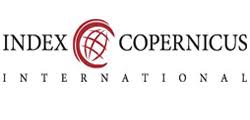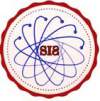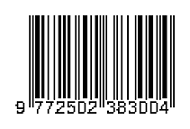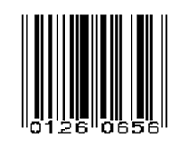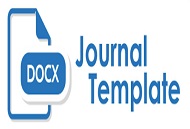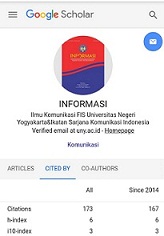MEDIA LITERACY AND SOCIAL MEDIA USAGE ANALYSIS IN COMMUNICATION AND NON-COMMUNICATION STUDENTS OF UNIVERSITY OF AMIKOM YOGYAKARTA
DOI:
https://doi.org/10.21831/informasi.v48i2.21382Keywords:
Media Literacy, Social Media Usage Pattern, Communication Student, Non-Communication StudentAbstract
Media literacy is the ability to understand, analyze, and deconstruct media images. The ability to do it is intended that the public as a media consumer becomes aware of how the media are built and accessed. The aims of this study are (1) to study the level of media literacy and social media usage patterns in communication and non-communication students. (2) to know the correlation between media literacy and social media usage patterns in communication and non-communication students. (3) comparing media literacy and social media usage patterns in communication and non-communication students. The population in this study were students of communication and non-communication at the University of AMIKOM Yogyakarta which amounted to 656. The sample selected in this study 87 respondents who conducted with probability sampling technique with convenience sampling. Data obtained through the survey to respondents by spreading the questionnaire at the early of September 2017. Data processing and analysis is done by descriptive study, crosstab, spearman correlation and chi-square. The result of the research shows that (1) the level of media literacy of both communication and non-communication students is at the intermediate level, while social media usage patterns for communication and non-communication students is at a high level. (2) there is the significant correlation between media literacy and social media usage patterns in communication and non-communication students. (3) there is a difference between media literacy and social media usage patterns in communication and non-communication students.
ANALISIS PENGGUNAAN LITERASI MEDIA DAN MEDIA SOSIAL DI MAHASISWA KOMUNIKASI DAN NON-MAHASISWA KOMUNIKASI UNIVERSITAS AMIKOM YOGYAKARTA
Literasi media adalah kemampuan untuk memahami, menganalisis, dan mendekonstruksi citra media. Kemampuan untuk melakukannya dimaksudkan agar publik sebagai konsumen media menjadi sadar bagaimana media dibangun dan diakses. Tujuan dari penelitian ini adalah (1) untuk mempelajari tingkat literasi media dan pola penggunaan media sosial pada mahasiswa komunikasi dan non-komunikasi. (2) untuk mengetahui hubungan antara literasi media dan pola penggunaan media sosial pada mahasiswa komunikasi dan non-komunikasi. (3) membandingkan literasi media dan pola penggunaan media sosial pada mahasiswa komunikasi dan non-komunikasi. Populasi dalam penelitian ini adalah mahasiswa komunikasi dan non-komunikasi di Universitas AMIKOM Yogyakarta yang berjumlah 656. Sampel yang dipilih dalam penelitian ini adalah 87 responden yang dilakukan dengan teknik probability sampling dengan convenience sampling. Data diperoleh melalui survei kepada responden dengan menyebarkan kuesioner pada awal September 2017. Pengolahan dan analisis data dilakukan dengan studi deskriptif, crosstab, korelasi spearman dan chi-square. Hasil penelitian menunjukkan bahwa (1) tingkat literasi media mahasiswa komunikasi dan non-komunikasi berada pada tingkat sedang, sedangkan pola penggunaan media sosial untuk mahasiswa komunikasi dan non-komunikasi berada pada tingkat yang tinggi. (2) ada hubungan yang signifikan antara literasi media dan pola penggunaan media sosial pada mahasiswa komunikasi dan non-komunikasi. (3) ada perbedaan antara literasi media dan pola penggunaan media sosial pada mahasiswa komunikasi dan non-komunikasi.
References
Baym, N.K., 2015. Personal connections in the digital age. John Wiley & Sons.
Baym, N.K., Zhang, Y.B., Kunkel, A., Ledbetter, A., Lin, M.-C., 2007. Relational quality and media use in interpersonal relationships. New Media Soc. 9, 735–752.
Brutus, S., Donia, M.B., 2010. Improving the effectiveness of students in groups with a centralized peer evaluation system. Acad. Manag. Learn. Educ. 9, 652–662.
Fuchs, C., 2017. Social media: A critical introduction. Sage.
Lenhart, A., Purcell, K., Smith, A., Zickuhr, K., 2010. Social Media & Mobile Internet Use among Teens and Young Adults. Millennials. Pew Internet Am. Life Proj.
Literat, I., 2014. Measuring New Media Literacies: Towards the Development of a Comprehensive Assessment Tool. J. Media Lit. Educ. 6, 15–27.
O'Keeffe, G.S., Clarke-Pearson, K., 2011. The impact of social media on children, adolescents, and families. Pediatrics 127, 800–804.
Potter, W.J., 2013. Media literacy. Sage Publications.
Silverblatt, A., Miller, D.C., Smith, J., Brown, N., 2014. Media Literacy: Keys to Interpreting Media Messages: Keys to Interpreting Media Messages. ABC-CLIO.
Urista, M.A., Dong, Q., Day, K.D., 2009. Explaining why young adults use MySpace and Facebook through uses and gratifications theory. Hum. Commun. 12, 215–229.
Youmans, W.L., York, J.C., 2012. Social media and the activist toolkit: User agreements, corporate interests, and the information infrastructure of modern social movements. J. Commun. 62, 315–329.
Downloads
Published
Issue
Section
License
Authors who publish with this journal agree to the following terms:- Authors retain copyright and grant the journal right of first publication with the work simultaneously licensed under a Creative Commons Attribution License that allows others to share the work with an acknowledgement of the work's authorship and initial publication in this journal.
- Authors are able to enter into separate, additional contractual arrangements for the non-exclusive distribution of the journal's published version of the work (e.g., post it to an institutional repository or publish it in a book), with an acknowledgement of its initial publication in this journal.
- Authors are permitted and encouraged to post their work online (e.g., in institutional repositories or on their website) prior to and during the submission process, as it can lead to productive exchanges, as well as earlier and greater citation of published work (See The Effect of Open Access).


